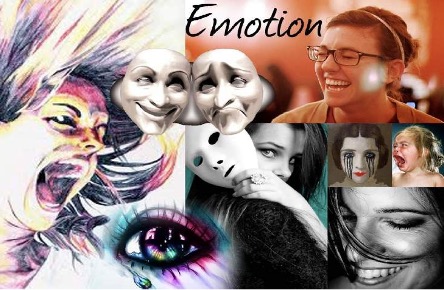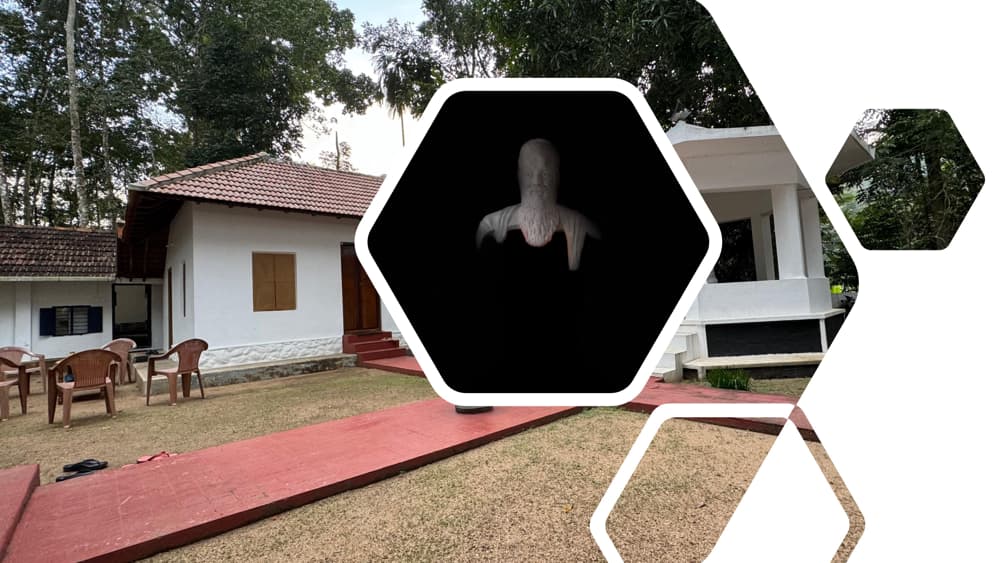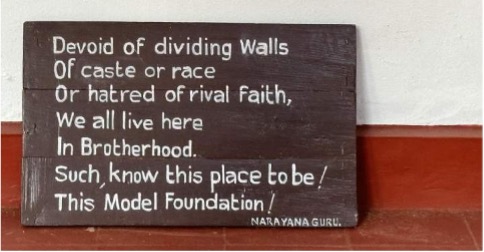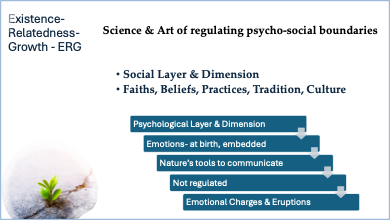Boundaries: Psycho-Social Boundaries-Contd.
Dear Readers, Welcome to SC Musings Blog 8,
SC Musings take me on introspective journeys, traversing past times and spaces, for connecting them with the now.
Did you have a peep into your psycho-social boundaries, and did they talk to You?
When I glance at boundaries, my narrative surfaces. The oneness of identity I experienced during my growing up years has gone to the background. However, it lingers there as a backdrop, giving me a sense of expansive awareness, making it easier for me to feel a oneness with the universe.

In this Blog 8, we will explore the Psychological and Social aspects of Psycho-Social boundaries independently; and later integrate them. The purpose of this study is to experientially learn the science and art of regulating psycho-social boundaries. This regulation, we believe is essential for ERG- our Existence-Relatedness-Growth (Alderfer, 1969).
Our psychological dimension and layer is present at birth, providing a vital connection with significant others and our environment; a newborn baby’s cry is the first indication of this connection. As the infant grows, the psychological layer, determined bio-chemically, expressed neuro-physiologically through behaviors, becomes shaped by societal regulations and conditionings. Here, I am attempting to capture the multitudinous agents and processes underlying the formation of the psychological dimension and layer.
Packed with emotions, which are tools provided by nature to deal with the environment, the psychological layer and dimension, manifests through moods and expressions, a few of which are displayed in Figure 8.2. Though we have advanced technologically, our understanding of our psychological layer is at a nascent stage. Even the developed countries, despite their proclaimed supremacy in wealth and development, are drawn into battles, packed with emotional charges. Exploration of positive emotions has begun in the last 3 plus decades, initiated by the Dalai Lama (Davidson, 2016) who invited neuroscientists to study positive emotions like compassion and joy, instead of focusing on anger, and depression. Thus, an awareness of the efficacy of these emotions to promote mental health has been identified.

Eastern psychology, (Yati, 2013.p.191-194; 1987. p.244, 415, 436) addresses emotions, through metaphors and practices; however, they are not accessible, even in the East, where people are under the spell of Western approaches. I began comprehending the depth of the wisdom of the East, and its applicability in life from the teachings Guru Nitya Chaitanya Yati and later from the writings of Aurobindo and Mother.
I came to know recently during my visit to Koni Gurukula in Kerala, that Guru Nitya, observed silence for 18 months, following a difference with his Guru. It is interesting to note the tool used by Guru to handle his emotions and relationships.

The deep Psycho-Social-Spiritual message of Narayana Guru in Figure 8.4 is a prescription for oneness through peace and harmony.

Avoiding the temptation we psychologists have to cut and paste these practices and prescriptions in our lives and work, I have begun delving deeper into my inner terrain. Transactional Analysis – TA, Taichi, and classes with Nancy Yeilding, (my mentor and a disciple of Guru Nitya, who heads the Bainbridge Gurukula) have guided me in this internal exploration.
Surveying our social dimension and layer is a relatively simpler task, because of its visibility and accessibility. Socialization begins at birth, or even in the womb, where transgenerational influences impact and influence (Berne, 2015. p.39 to 41; Gayol, 2004).
Our social layer and dimension is a composite of faiths, beliefs, tradition, and culture which have seeped into our system, as a result of socialization processes. Unlike the psychological layer which resides and is embedded in the deeper layer of consciousness, the social layer, though deep and multi-dimensional, is visible in our communications, behaviors, and the environments we create and are surrounded by. The psychological layer creeps in insidiously, often masked as logic, care, concern, etc.
Ego states (Berne, 2015) described in Blog 7 capture our psychological and social dimensions and layers, succinctly. Child ego state, a repository of experiences from birth and beyond determines how our past influences our personality today; while our Parent ego state, containing parental voices, is experienced as our inner voice and also manifested in our behaviors.
Having studied psychological and social layers separately, we can now see how they integrate. Our emotional expression is determined by our social conditionings and the reverse also takes place; that is, we interpret social norms and adapt them to suit our psychological propensities.

This intricate integration and enmeshing of psycho-social layers and dimensions adds complexity to understanding human beings, making us unpredictable. Evidenced by the Bengaluru CEO’s crime (2024) in January this year, wherein she is reported to have murdered her 4-year son to avenge her husband. Though a one-off case, it is indicative that understanding alone does not provide the necessary answers and tools for growth and development.
In this quagmire of emotions and social compulsions, we get caught between questions of right and wrong, just, and unjust, taking a microscopic view of ourselves, others, and our environment, not factoring in time and space. Pressing the pause button to look at our psycho-social boundaries, provides a respite. This process demands an inner journey of reflection and contemplation, which we will explore in Blog 9.
Dear Readers, I invite you to let thoughts or images of your boundaries rise in you - and to be a witness to them. How about looking at your psycho-social boundaries a wee bit deeper- to see who’s there? Also, notice the sensations in your body when you experience your boundaries.
In our next Blog, we will discover strategies to regulate our psycho-social boundaries.

References
Alderfer, C.P. (1969). An empirical test of a new theory of human needs, Organizational Behavior and Human Performance, Volume 4, Issue 2,1969, Pages 142-175, ISSN 0030-5073,
Berne, E. (2015). (original work published 1961). Transactional Analysis in Psychotherapy. Systematic Individual and Social Psychiatry. Martino Publishing
Davidson, R. (2016). The Science of a Happy Mind, Part 1 | Nat Geo Live. 10.45. https:// you tu.be/ELLeIMFIWy0
Nation Numbed by Bengaluru CEO Mother's Crime: Disturbing Revelations In Goa Murder Case (2024) https://www.youtube.com/watch?v=WtroXLmOYIk&t=2s
Gayol, G.N. (2004) Codependence: A Transgenerational Script, Transactional Analysis Journal, 34:4, 312-322, DOI: 10.1177/036215370403400404
Yati, G.N.C. (1987). The Psychology of Darsanamala. New Delhi: D. K. Printworld
Yati, G. N. C. (2013). (original work published 2003). That alone, the core of wisdom: A commentary on atmopadesa satakam, the one hundred verses of self-instruction of Narayana Guru. New Delhi: D. K. Printworld